2019 MERCEDES-BENZ G-CLASS weight
[x] Cancel search: weightPage 44 of 514

#
Donotpl ace anyob jects betwee nth e
sitting surface and thech ild restra int
sy stem. #
The entire base ofthech ild restra int
sy stem mus talw aysre st on thesitt ing
sur face ofthefront passeng erseat. #
The backres tof thefo rw ard-f acin gch ild
re stra int system mus t,as faras possi ‐
ble, beresting ontheseat backres tof
th efront passeng erseat. #
Alw ayscom plywit hth ech ild restra int
sy stem manuf acturer'sinstallation
ins truct ions . A
per son onthefront passeng erseat must
obser vethefo llo wing informatio n:
R Fasten seat belts correctl y(/ page 33).
R Sitinan almos tupr ight seatposi tion with
th eir bac kag ains tth eseat backres t.
R Sitwithth eir feet resting onthefloor ,if pos‐
sible. The
front passeng erfront airbag mayot her wise
be disable dby mis take ,fo rex am ple inthefo l‐
lo wing situat ions:
R The front passen gertr ansf ersth eir weight by
suppor tingthemselv eson ave hicle armr est.
R The front passeng ersits insuc hawa yth at
th eir weight israised from thesitt ing sur‐
fa ce. &
WARNIN GRisk ofinju ryor deat hdue to
deactiv ated front passeng erairbag
If th ePA SSENGER AIRBAGOF Find icat or
lam pis lit,th efront passeng erairbag isdisa‐
bled. Itwill notbe deplo yedin theeve ntof
an acci dent and canno tpe rfor m its intended
pr otect ive func tion.
A per son inthefront passeng erseat could
th en, forex am ple, com eint ocon tact with
th eve hicle interior ,especially ifth eper son is
sitt ing tooclose tothecoc kpit. If
th efront passeng erseat isoccupied,
alw aysensur eth at:
R The classificat ion oftheper son inthe
fr ont passeng ersea tis cor rect and the
fr ont passeng erairb agisenabl edordisa ‐
ble din accor dance withth eper son inthe
fr ont passeng ersea t.
R The front passeng ersea thas been moved
as farbac kas possi ble.
R The person isseat edcor rectl y. #
Ensu re,bo th bef oreand during thejour‐
ne y,that thest atus ofthefront
passeng erairbag iscor rect. If
th efront passeng erseat isoccupied, theclas‐
sif ication oftheper son orchild restra int system
on thefront passeng erseat take splace afte rth e
fr ont passeng erfront airbagshut offself-t est.
The PASSENGER AIRBAGind icat orlam psdis‐
pla yth est atus ofthefront passeng erfront air‐
bag.
Alw aysobser vetheno teson thefunc tion ofthe
PA SSENGER AIRBAGind icat orlam ps
(/ page43). 42
Occupan tsaf ety
Page 49 of 514
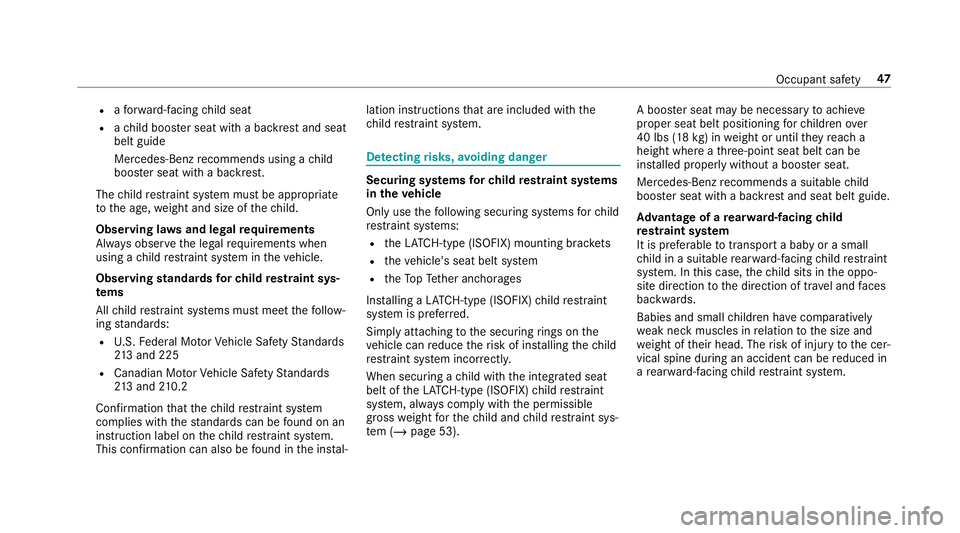
R
afo rw ard-f acin gch ild seat
R ach ild boos terseat withabac kres tand seat
belt guide
Mer cedes-Benz recomme ndsusing ach ild
boos terseat withabac kres t.
The child restra int system mus tbe appr opriate
to theag e, we ight andsize ofthech ild.
Obser vinglaws and legalrequ irement s
Alw aysobser vetheleg alrequ iremen tswhen
using ach ild restra int system intheve hicle.
Obser vingstandar dsforch ild restra int sys‐
te ms
All child restra int systems mustmee tth efo llo w‐
ing standar ds:
R U.S. Feder alMo torVe hicle SafetySt andar ds
21 3and 225
R Canadi anMo torVe hicle SafetySt andar ds
21 3and 210.2
Conf irmatio nth at thech ild restra int system
com plies withth est andar dscan befound onan
ins truct ion label onthech ild restra int system.
This confirm atio ncan also befound intheins tal‐ lation
instruct ions that areinc luded withth e
ch ild restra int system. De
tectin grisk s,avoiding dang er Secur
ingsystems forch ild restra int systems
in theve hicl e
Onl yuse thefo llo wing secur ingsystems forch ild
re stra int systems:
R theLA TC H-type (ISOFIX )mou nting brac kets
R theve hicle's seatbeltsystem
R theTo pTe ther anc horages
Ins talling aLA TC H-type (ISOFIX )ch ild restra int
sy stem isprefer red.
Sim plyattaching tothesecur ingrings onthe
ve hicle canreduce therisk ofins talling thech ild
re stra int system incor rectly .
Whe nsecu ring ach ild withth eint egr ated seat
belt oftheLA TC H-type (ISOFIX )ch ild restra int
sy stem, alwayscom plywit hth eper missible
gr oss weight forth ech ild and child restra int sys‐
te m (/ page53). A
boos terseat maybe necessar yto achie ve
pr oper seatbeltposition ingforch ildr enover
40 lbs (18 kg )in we ight orunt ilth ey reac ha
heigh twher eath re e-point seatbeltcanbe
ins talled proper lywit hout aboos terseat.
Mer cedes-Benz recomme ndsasu itab lech ild
boos terseat withabac kres tand seat beltguide.
Ad vantag eof are ar wa rd-faci ng child
re stra int system
It is prefer able totrans portabab yor asmall
ch ild inasuit able rear wa rd-faci ng child restra int
sy stem. Inthis case, thech ild sits intheoppo‐
sit edir ect ion tothedir ect ion oftrave land faces
ba ckwa rds.
Babies andsmall childr enhave com parativ ely
we ak nec kmusc lesinrelation tothesize and
we ight oftheir head. Therisk ofinjur yto thecer‐
vical spine during anacciden tcan bereduced in
a re ar wa rd-faci ng child restra int system. Occ
upant safety 47
Page 93 of 514
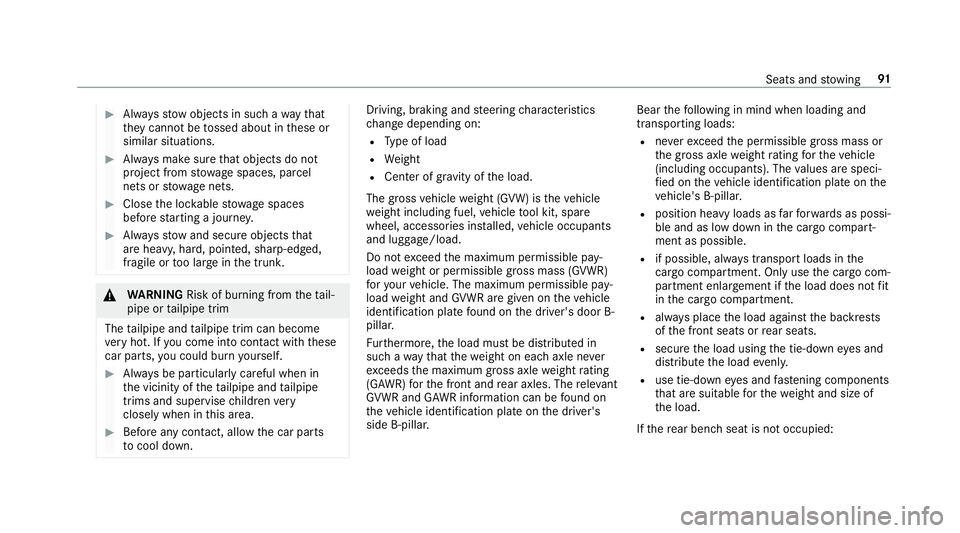
#
Alw aysst ow object sin suc hawa yth at
th ey canno tbe tossed about inthese or
similar situation s. #
Alw aysmak esur eth at obj ect sdo not
pr oject from stow agespac es,parcel
ne ts or stow agene ts. #
Close theloc kable stow agespac es
bef orest ar tin gajo ur ne y. #
Alw aysst ow and secureobj ect sth at
ar ehea vy,har d,poin ted, shar p-edg ed,
fr agile ortoolarg ein thetrunk . &
WARNIN GRisk ofburning from theta il‐
pipe ortailpipe trim
The tailpipe andtailpipe trim can becom e
ve ry hot.Ifyo uco me intoco ntact withth ese
car parts,youco uld burnyo urself . #
Alw aysbe par ticular lycareful whenin
th evicinit yof theta ilpipe andtailpipe
tr ims and super visechildr envery
clos elywhe nin this area. #
Beforean ycon tact, allo w thecar parts
to cool down. Dr
iving, braki ng and steer ing charact eristic s
ch ang edepen dingon :
R Type ofload
R Weight
R Cent erofgrav ity oftheload.
The gross vehicle weight (GVW) istheve hicle
we ight including fuel,vehicle tool kit, spar e
wheel, accessor iesinstalled, vehicle occupants
and luggage/load.
Do notex ceed themaximum permissible pay‐
load weight orper missib legross mass (GVWR)
fo ryo ur vehicle. Themaximum permissible pay‐
load weight andGVWR aregiv en on theve hicle
identif ication platefo und onthedr iver's door B-
pillar .
Fu rther mor e,theload mustbe distribut edin
suc hawa yth at thewe ight oneac haxle never
exc eeds themaximum gross axle weight rating
(GA WR)fo rth efront and rear axle s.The releva nt
GV WR and GAWR information canbefound on
th eve hicle identif ication plateon thedr iver's
side B-pillar . Bear
thefo llo wing inmin dwhen loading and
transpor tingloads:
R neverexc eed theper missible gross mass or
th egr oss axle weight rating forth eve hicle
(including occupants). Thevalues arespec i‐
fi ed on theve hicle identif ication plateon the
ve hicle's B-pillar.
R position heavyloads asfarfo rw ards asposs i‐
ble and aslow do wn inthecar gocom part‐
ment aspossible.
R ifpossible, alwaystranspor tloads inthe
cargo compartment. Onlyusethecar gocom‐
par tmen tenlar gement ifth eload does notfit
in thecar gocom partmen t.
R alwaysplace theload agains tth ebac kres ts
of thefront seats orrear seat s.
R secureth eload using thetie-do wneyes and
dis tribut eth eload evenly.
R use tie-do wn eyesand fastening componen ts
th at aresuit able forth ewe ight andsize of
th eload.
If th ere ar ben chseat isno toccupied: Seats
andstow ing 91
Page 366 of 514
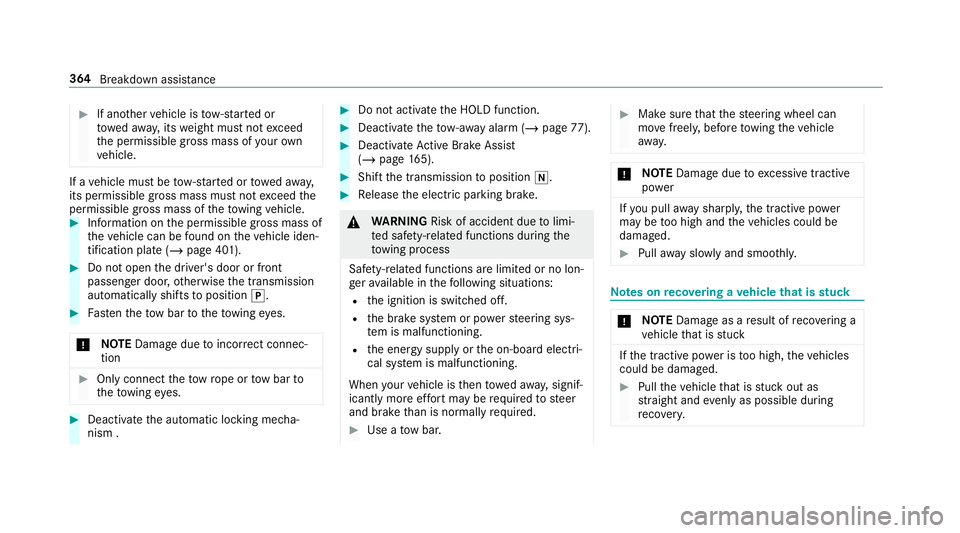
#
Ifano ther vehicle istow- star tedor
to we daw ay,its weight mustno texc eed
th eper missible gross mass ofyour ow n
ve hicle. If
ave hicle mustbe tow- star tedor towe daw ay,
its per missib legross mass mustno texc eed the
per missible gross mass oftheto wing vehicle. #
Information ontheper missible gross mass of
th eve hicle canbefound ontheve hicle iden‐
tif ication plate(/ page40 1). #
Donotopen thedr iver's door orfront
passeng erdoor ,ot her wise thetransmission
aut omaticall yshif tsto position 005D. #
Fasten theto w bar totheto wing eyes.
* NO
TEDama gedue toinc orrect connec‐
tion #
Onlyconnect theto w rope ortow bar to
th eto wing eyes. #
Deact ivat eth eaut omatic locking mecha‐
nism . #
Donotactiv ateth eHOLD function. #
Deact ivat eth eto w- aw ay alar m(/ page77 ). #
Deac tivateAc tiveBr ak eAssi st
( / pag e16 5). #
Shif tth etra nsmiss iontoposition 005C. #
Release theelectr icpar king brak e. &
WARNIN GRisk ofacci dent dueto limi‐
te dsaf ety-re lat ed func tionsdur ing the
to wing proce ss
Saf ety-re lat ed func tionsar elimit edorno lon‐
ge rav ailable inthefo llo wing situat ions:
R theignition isswitc hedoff.
R thebr ak esy stem orpowe rst eer ing sys‐
te m ismalfu nctioning.
R theener gysupply ortheon- boar delectr i‐
cal system ismalfunct ioning.
When your vehicle isthen towe daw ay,signif ‐
icant lymor eef fort ma ybe requ ired tosteer
and brak eth an isno rm allyre qu ired. #
Use ato w bar . #
Mak esur eth at thesteer ing wheel can
mo vefreely ,bef oreto wing theve hicle
aw ay. *
NO
TEDama gedue toexcess ive tracti ve
po we r If
yo upull away shar ply, thetractiv epo we r
ma ybe toohigh andtheve hicles couldbe
damag ed. #
Pull away slo wlyand smoo thly. No
teson reco vering ave hicl eth at isstuc k *
NO
TEDama geasare sult ofreco vering a
ve hicle that isstuc k If
th etractiv epo we ris toohigh, theve hicles
could bedamag ed. #
Pull theve hicle that isstuc kout as
st ra ight andevenlyas possi ble du ring
re co very. 36
4
Breakdo wnassis tance
Page 379 of 514

On-boar
dcom puter:
4 Service 5
Tires #
Swipe down wardson Touc hCon trol on the
lef t-hand sideofthesteer ing wheel.
The Use Current Pressures asNew Refer-
ence Values? messageis sho wninthemulti‐
func tion displa y. #
Tobegin restar t,pr ess Touc hCon trol on the
lef t-hand sideofthesteer ing wheel.
The Tire Press. MonitorRestart edmessag eis
sho wninthemultifunc tiondispla y.
Cur rent wa rning mess ages aredele tedand
th eye llo w0077 warning lam pgoes out.
Af teryo uha ve been driving fora fe w
minut es,thesy stem checks whe ther thecur‐
re nt tirepr ess ures arewi thin thespecif ied
ra ng e. The current tirepr ess ures areth en
accep tedas refere nce values andmon itor ed.
Mak esur eto obser vethefo llo wing further rela‐
te dsubjec t:
R Noteson tirepr essur e(/ page37 1) Ra
dio equipme ntappr oval of thetir epr es‐
sur emoni toring system
Ra dio equipme ntappr oval number s Co
untr yR adiotype approval number
Ca nada IC:2546A -AG5S P4
US AF CCID:MRXA G5SP4
FCC ID:MRXM FR Fu
rther information onthedeclar ationofcon ‐
fo rm ity forwir eles sve hicle component s
(/ page23). Loading
theve hicl e No
teson Tire and Loading Information plac‐
ar d &
WARNIN GRisk ofacci dent from overloa‐
ded tires
Ov erloaded tires ma yove rheat and burstas a
con sequenc e.Ov erloaded tires can also im
pair thesteer ing and handling charact eris‐
tic sand lead tobrak efa ilur e. #
Obser vetheload-bear ingcapacity of
th etir es. #
The load-bear ingcapacity mustbe at
leas thalf thegr oss axle weight rating of
th eve hicle. #
Neverove rload thetir es by exc eeding
th emaximum load. The
Tire and Loadi ngInfo rm atio nplacar dis on
th eB-pillar onthedr iver's side oftheve hicle. 1
Tire and Loadi ngInfo rm atio nplacar d Whee
lsand tires 37
7
Page 380 of 514

%
The datasho wnintheillus tration isexam ple
dat a.
The Tire and Loadi ngInfo rm atio nplacar dsho ws:
R Maximum numberofseats 2accor dingto
th emaximum numberofpeople permitt edto
tr ave lin theve hicle.
R Maximum permissible load3com prises the
gr os swe ight ofall vehicle occupants, load
and luggage. R
Recomme ndedtirepr ess ures 1 forcold
tir es. The recomme ndedtirepr ess ures are
va lid forth emaximum permissible loadand
up tothemaximum permissible vehicle
speed.
Please alsonote:
R Information onper missib lewe ight sand loads
on theve hicle identif ication plate
(/ page40 1).
R Information ontirepr essur ein thetir epr es‐
sur eta ble (/ page37 3).
Fu rther relat ed subje cts:
R Determ inin gth emaximum permissible load
(/ page37 8)
R Noteson tirepr essur e(/ page37 1). De
term ining thema xim um permis sible load The
follo wing steps have been developed as
re qu ired ofall manuf acturersunder Title 49,
Co de ofU.S. Feder alRe gulations, Part57 5, pur‐
sua nttothe"N ational Traf fic and MotorVe hicle
Saf etyAc tof 1966". #
Ste p1: loca tethest at emen t"The combined
we ight ofocc upant sand load should never
exc eed XXX kgorXXX lbs." ("The combined
we ight ofocc upant sand load should never
exc eed XXX kgorXXX lbs.") onyour vehicle's
Ti re and Loadi ngInfo rm atio nplacar d. #
Ste p2: determ ine thecombin edweight of
th edr iver and passeng ersth at will betravel‐
ing inyour vehicle. #
Ste p3: subtr act thecombin edweight ofthe
dr iver and passeng ersfrom XXX kgor
XXX lbs. #
Ste p4: there sulting figur eeq uals theper‐
missible cargoand luggageload capacity .Fo r
ex am ple: If"XXX "eq uals 1400 lbs and ther e
ar efive occupant sin your vehicle witha
we ight of150lbs eac h,themaximum cargo
and luggageload capacity is650 lbs(1400 -
75 0(5 x15 0) =650 lbs). #
Ste p5: determ ine thecombin edweight of
lugg ageand load that theve hicle willbecar‐
ry ing. Forsaf etyre ason s,this we ight mayno t
saf elyexc eed theav ailable cargoand lug‐
ga ge load capac itycalc ulatedinstep 4. 37
8
Wheels andtires
Page 381 of 514
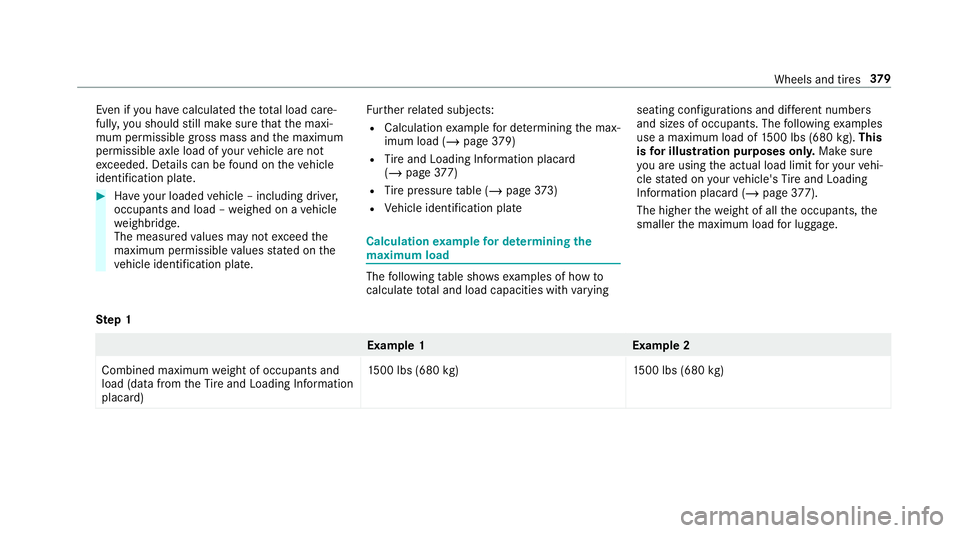
Ev
en ifyo uha ve cal cul ated thetot alload care‐
full y,yo usho uld still mak esur eth at themaxi‐
mum permissible gross mass andthemaximum
per missible axleload ofyour vehicle areno t
exc eeded. Details can befound ontheve hicle
identif ication plate. #
Have your loaded vehicle –including driver ,
occupants andload –we ighed onave hicle
we ighbr idge.
The measur edvalues mayno texc eed the
maximu mper missi blevalues stat ed on the
ve hicle identif ication plate. Fu
rther relat ed subje cts:
R Calculation exam ple forde term inin gth emax‐
imum load(/page37 9)
R Tire and Loadi ngInfo rm atio nplacar d
(/ page37 7)
R Tire pressur eta ble (/ page37 3)
R Vehicle identif ication plate Calculation
exam ple forde term ining the
ma ximum load The
follo wing table showsexam ples ofhowto
cal cul atetot aland load capac ities wit hva rying seatin
gcon figur ations anddiffere nt num bers
and sizes ofocc upant s.The follo wing exam ples
use amax imum loadof1500 lbs (680 kg).This
is forillus tratio npur pos esonly.Mak esur e
yo uar eusin gth eactual loadlimit foryo ur vehi‐
cle stat ed on your vehicle's Tire and Loadi ng
In fo rm atio nplacar d(/ page37 7).
Th ehigh er thewe ight ofall theoccupant s,the
smaller themaximum loadforlug gage .
Ste p1 Ex
am ple 1E xamp le2
Combine dmaxim umweight ofocc upant sand
load (datafrom theTire and Loadi ngInfo rm atio n
placar d) 15
00 lbs (680 kg)1 500lbs(680 kg) Wheels
andtires 37
9
Page 382 of 514
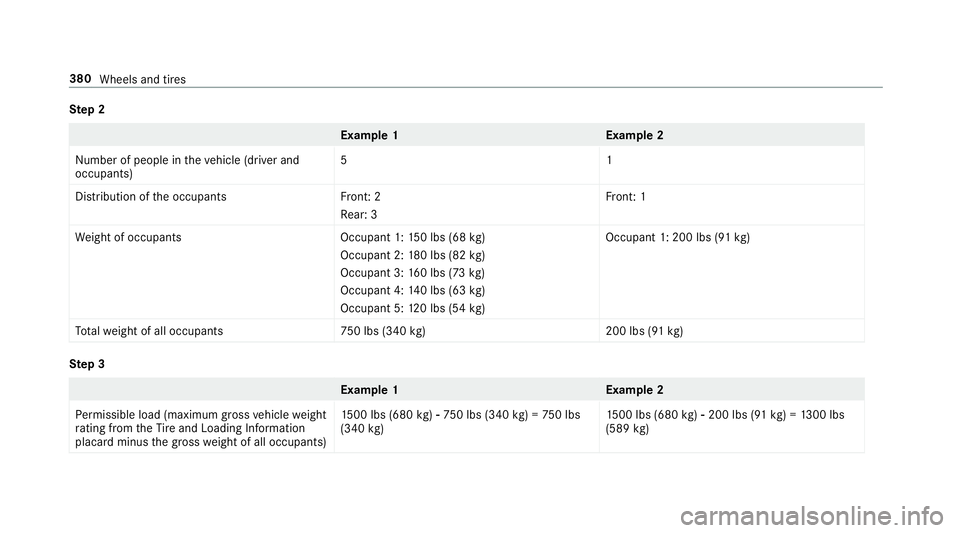
Ste
p2 Ex
am ple 1E xamp le2
Nu mb erofpeople intheve hicle (driver and
occupants) 51
Dis trib uti on oftheoccupant sF ront:2
Re ar:3 Fr
ont :1
We ight ofocc upant sO ccupant1:150lbs (68 kg)
Occupant 2:180lbs (82 kg)
Occupant 3:160lbs (73 kg )
Occupant 4:140lbs (63 kg)
Occupant 5:120lbs (54kg ) Occupant
1:200 lbs(91 kg )
To talwe ight ofall occ upant s7 50lbs (340 kg)2 00lbs (91 kg ) Ste
p3 Ex
am ple 1E xamp le2
Pe rm issible load(maxim umgros sve hicle weight
ra ting from theTire and Loadi ngInfo rm atio n
placar dmin usthegr oss weight ofall occ upant s)15
00 lbs (680 kg)00F8 75 0lbs (340 kg)= 75 0lbs
(340 kg) 15
00 lbs (680 kg)00F8 200 lbs(91 kg )= 13 00 lbs
(589 kg) 380
Wheels andtires